
The successful holding of the four consecutive CIIE has brought many cases of "exhibits becoming commodities", and in the medical field full of science and technology, the landing results of star products have benefited more Chinese patients.
Medtronic brought the world's smallest pacemaker Mira became a "star" as soon as it debuted at the first CIIE, the traditional pacemaker is about the size of a tea bag, while the Mica is a leadless pacemaker, only the size of a coin, which can be "stationed" in the heart of arrhythmia patients in a minimally invasive way. Without wires, without capsules, patients do not even feel its presence, becoming the "invisible guardian" of heart health, with a lifespan of more than 10 years and compatibility with innovative features such as 1.5 T/3.0 T whole body MRI scans.
On June 11, 2019, the State Drug Administration officially announced that it approved the domestic listing of Micro through a special approval procedure for innovative medical devices. At present, it has landed in many hospitals across the country.
Recently, in the interventional catheter room of Changhai Hospital, the team of Director Guo Zhifu, Professor Zhao Xianxian and Professor Qin Yongwen of the Department of Cardiovascular Medicine successfully completed a case of pacing electrode extraction + leadless pacemaker implantation.
The patient, a 72-year-old male, underwent double-chamber pacemaker implantation in the outer hospital in 2008 due to intermittent third-degree atrioventricular block and pacemaker replacement in 2016 due to pacemaker battery depletion. Before January, there was no obvious precipitating skin rupture of the sac, and the pacing wire was partially exposed. However, considering the patient's age and the longer implantation time of pacemaker electrodes, doctors have advised them to treat them conservatively.
After understanding the patient's condition and physical condition, Professor Zhao Xianxian and Professor Qin Yongwen decided to give the pacemaker electrodes unplugged and implanted a leadless pacemaker at the same time. The entire surgical procedure takes only 2 hours.
▲Comparison of traditional pacemaker and leadless pacemaker Micra.
Professor Zhao Xianxian introduced that infection is one of the most common complications after pacemaker implantation, once a pacemaker infection occurs, patients have the risk of developing infective endocarditis, sepsis, local debridement and intensive anti-infection treatment is often ineffective, the current domestic and foreign guidelines recommend that the entire set of pacemaker devices be removed as soon as possible to avoid serious consequences. The surgical extraction of the pacemaker electrode is difficult and risky, and patients may experience cardiac tamponade, hemothoraphalot, pulmonary embolism, mediastinal bleeding, and even death at any time. At present, most hospitals in China do not carry out such surgeries.
For this patient, the implantation of a leadless pacemaker at the same time after electrode removal is undoubtedly the best choice. The leadless pacemaker eliminates a variety of complications, has the advantages of small trauma and rapid recovery, and does not affect the patient's exercise at all after surgery, which significantly improves the quality of life of the patient.
Author: Zhou Yuan
Editor: Wang Wanyi
Editor-in-charge: Zhang Xiaoming
*Wenhui exclusive manuscript, please indicate the source when reprinting.